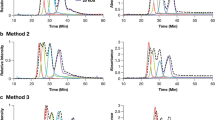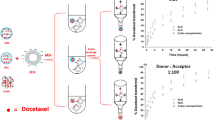Abstract
Purpose
Nanoparticles have been used in diverse areas, and even broader applications are expected in the future. Since surface modification can influence the configuration and toxicity of nanoparticles, a rapid screening method is important to ensure nanoparticle quality.
Methods
We examined the effect of the nanoparticle surface morphology on the HPLC elution profile using two types of 100-nm liposomal nanoparticles (AmBisomeⓇ and DOXILⓇ).
Results
These 100-nm-sized nanoparticles eluted before the holdup time (about 4 min), even when a column packed with particles with a relatively large pore size (30 nm) was used. The elution time of the nanoparticles increased with pegylation of the nanoparticles and protein adsorption to the nanoparticles; however, the nanoparticles still eluted before the holdup time.
Conclusions
The results of this study indicate that HPLC is a suitable tool for rapid evaluation of the surface of liposomal nanoparticles.





Similar content being viewed by others
Abbreviations
- BCA:
-
Bicinchoninic acid
- CE:
-
Capillary electrophoresis
- DAD:
-
Diode array detector
- DLS:
-
Dynamic light scattering
- Ex.:
-
Excitation
- Em.:
-
Emission
- DSPE:
-
1,2-Distearoyl-sn-glycero-3-phosphoethanolamine
- HPLC:
-
High performance liquid chromatography
- NMR:
-
Nuclear magnetic resonance
- PEG:
-
Polyethyleneglycol
- TSP:
-
3-(Trimethylsilyl)propionic 2,2,3,3-d4 acid
References
Rosi NL, Mirkin CA. Nanostructures in biodiagnostics. Chem Rev. 2003;105(4):1547–62.
Ge J, Neofytou E, Cahill TJ, Beygui RE, Zare RN. Drug release from electric-field-responsive nanoparticles. ACS Nano. 2012;6(1):227–33.
Murayama S, Jo J, Shibata Y, Liang K, Santa T, Saga T, et al. The simple preparation of polyethylene glycol-based soft nanoparticles containing dual imaging probes. J Mater Chem B. 2013;1(38):4932–8.
Nishiyama N, Iriyama A, Jang WD, Miyata K, Itaka K, Inoue Y, et al. Light-induced gene transfer from packaged DNA enveloped in a dendrimeric photosensitizer. Nat Mater. 2005;4(12):934–41.
Kato M. Development of analytical methods for functional analysis of intracellular protein using signal-responsive silica or organic nanoparticles. J Pharm Biomed Anal. 2016;118(1):292–306.
Itoh N, Sano A, Santa T, Kato M. Simultaneous analysis of nanoparticles and small molecules by high-performance liquid chromatography using a silica monolithic column. Analyst. 2014;139(18):4453–7.
Itoh N, Santa T, Kato M. Rapid evaluation of the quantity of drugs encapsulated within nanoparticles by high-performance liquid chromatography in a monolithic silica column. Anal Bioanal Chem. 2015;407(21):6429–34.
Itoh N, Santa T, Kato M. Rapid and mild purification method for nanoparticles from a dispersed solution using a monolithic silica disk. J Chromatogr A. 2015;1404(1):141–5.
Yamamoto T, Murakami Y, Motoyanagi J, Fukushima T, Maruyama S, Kato M. An analytical system for single nanomaterials: hyphenation of capillary electrophoresis with Raman spectrometry or with scanning probe microscopy for individual single-walled carbon nanotube analysis. Anal Chem. 2009;81(17):7336–41.
Yamamoto T, Murayama S, Kato M. Fluorescence derivatization of single walled carbon nanotubes for analysis by means of conventional CE-LIF. J Sep Sci. 2011;34(20):2866–71.
Kato M, Sasaki M, Ueyama Y, Koga A, Sano A, Higashi T, et al. Comparison of the migration behavior of nanoparticles based on polyethylene glycol and silica using micellar electrokinetic chromatography. Electrophoresis. 2015;38(3):468–74.
Amin ML, Joo JY, Yi DK, An SSA. Surface modification and local orientations of surface molecules in nanotherapeutics. J Control Release. 2015;207(1):131–42.
Karakoti AS, Hench LL, Seal S. The potential toxicity of nanomaterials-The role of surfaces. JOM. 2006;58(7):77–82.
Jo DH, Kim JH, Lee TG, Kim JH. Size, surface charge, and shape determine therapeutic effects of nanoparticles on brain and retinal diseases. Nanomedicine. 2015;11(7):1603–11.
Moore TL, Rodriguez-Lorenzo L, Hirsch V, Balog S, Urban D, Jud C, et al. Nanoparticle colloidal stability in cell culture media and impact on cellular interactions. Chem Soc Rev. 2015;44(17):6287–305.
Tenzer S, Docter D, Kuharev J, Musyanovych A, Fetz V, Hecht R, et al. Rapid formation of plasma protein corona critically affects nanoparticle pathophysiology. Nat Nanotech. 2013;8(10):772–81.
Baer DR, Gaspar DJ, Nachimuthu P, Techane SD, Castner DG. Application of surface chemical analysis tools for characterization of nanoparticles. Anal Bioanal Chem. 2010;396(3):983–1002.
Baer DR, Amonette JE, Engelhard MH, Gaspar DJ, Karakoti AS, Kuchibhatla S, et al. Characterization challenges for nanomaterials. Surf Interface Anal. 2008;40(3–4):529–37.
Koh AL, Shachaf CM, Elchuri S, Nolan GP, Sinclair R. Electron microscopy localization and characterization of functionalized composite organic–inorganic SERS nanoparticles on leukemia cells. Ultramicroscopy. 2008;109(1):111–21.
Gupta S, Brouwer P, Bandyopadhyay S, Patil S, Briggs R, Jain J, et al. TEM/AFM investigation of size and surface properties of nanocrystalline ceria. J Nanosci Nanotechnol. 2005;5(7):1101–7.
Lim J, Yeap SP, Che HX, Low SC. Characterization of magnetic nanoparticle by dynamic light scattering. Nanoscale Res Lett. 2013;8:381.
Jimenez VL, Leopold MC, Mazzitelli C, Jorgenson JW, Murray RW. HPLC of monolayer-protected gold nanoclusters. Anal Chem. 2003;75(2):199–206.
Song Y, Jimenez V, McKinney C, Donkers R, Murray RW. Estimation of size for 1–2nm nanoparticles using an HPLC electrochemical detector of double layer charging. Anal Chem. 2003;75(19):5088–96.
Choi MMF, Douglas AD, Murray RW. Ion-pair chromatographic separation of water-soluble gold monolayer-protected clusters. Anal Chem. 2006;78(8):2779–85.
Cabral H, Kataoka K. Progress of drug-loaded polymeric micelles into clinical studies. J Control Release. 2014;190(1):465–76.
Devadasu VR, Bhardwaj V, Kumar MN. Can controversial nanotechnology promise drug delivery? Chem Rev. 2013;113(3):1686–735.
Walkey CD, Olsen JB, Guo H, Emili A, Chan WCW. Nanoparticle size and surface chemistry determine serum protein adsorption and macrophage uptake. J Am Chem Soc. 2012;134(4):2139–47.
Lesieur S, Grabielle-Madelmont C, Paternostre M, Ollivon M. Study of size distribution and stability of liposomes by high performance gel exclusion chromatography. Chem Phys Lipids. 1993;64(1–3):57–82.
Zabaleta V, Campanero MA, Irache JM. An HPLC with evaporative light scattering detection method for the quantification of PEGs and Gantrez in PEGylated nanoparticles. J Pharm Biomed Anal. 2007;44(5):1072–8.
Cornely OA, Maertens J, Bresnik M, Ebrahimi R, Ullmann AJ, Bouza E, et al. Liposomal amphotericin B as initial therapy for invasive mold infection: A randomized trial comparing a high-loading dose regimen with standard dosing (AmBiLoad trial). Clin Infect Dis. 2007;44(10):1289–97.
Jiang W, Lionberger R, Yu LX. In vitro and in vivo characterizations of PEGylated liposomal doxorubicin. Bioanalysis. 2011;3(3):333–44.
Amamoto T, Hirata Y, Takahashi H, Kamiya M, Urano Y, Santa T, et al. Spatiotemporal activation of molecules within cells using silica nanoparticles responsive to blue-green light. J Mater Chem B. 2015;3(37):7427–33.
Amamoto T, Santa T, Kato M. Reduction of molecular leaching from a gel matrix for the precisely controlled release of encapsulated molecules by light stimulus. Chem Pharm Bull. 2014;62(7):649–53.
Maeda N, Takeuchi Y, Takada M, Namba Y, Oku N. Synthesis of angiogenesis-targeted peptide and hydrophobized polyethylene glycol conjugate. Bioorg Med Chem Lett. 2004;14(4):1015–7.
Takagi K, Murayama S, Sakai T, Asai M, Santa T, Kato M. A computer simulation study of the network structure of a hydrogel prepared from a tetra-armed star pre-polymer. Soft Matter. 2014;10(20):3553–9.
Murayama S, Ishizuka F, Takagi K, Inoda H, Sano A, Santa T, et al. Small-mesh-size hydrogel for functional photocontrol of encapsulated enzymes and small fluorescent probes. Anal Chem. 2012;84(3):1374–9.
Gunawan C, Lim M, Marquis CP, Amal R. Nanoparticle–protein corona complexes govern the biological fates and functions of nanoparticles. J Mater Chem B. 2014;2(15):2060–83.
Casals E, Pfaller T, Duschl A, Oostingh GJ, Puntes V. Time evolution of the nanoparticle protein corona. ACS Nano. 2010;4(7):3623–32.
Walkey CD, Chan WCW. Understanding and controlling the interaction of nanomaterials with proteins in a physiological environment. Chem Soc Rev. 2012;41(7):2780–99.
Lynch I, Dawson KA. Protein-nanoparticle interactions. Nano Today. 2008;3(1–2):40–7.
Lundqvist M, Stigler J, Cedervall T, Berggård T, Flanagan MB, Lynch I, et al. The evolution of the protein corona around nanoparticles: a test study. ACS Nano. 2011;5(9):7503–9.
ACKNOWLEDGMENTS AND DISCLOSURES
This work was supported by grants (Kakenhi) from the Ministry of Education, Culture, Sports, Science, and Technology (MEXT) of Japan, and JSPS Core-to-Core Program, A. Advanced Research Networks. We thank Prof. T. Ozeki (Nogoya City Univ., Japan) and Mr. K. Kurono (Shoko Scientific Co., Ltd., Japan) for advice of pegylation of AmBisomeⓇ and technical assistance with the size analysis of the nanoparticles using MALS, respectively. The author declares no competing financial interest.
Author information
Authors and Affiliations
Corresponding author
Rights and permissions
About this article
Cite this article
Itoh, N., Yamamoto, E., Santa, T. et al. Effect of Nanoparticle Surface on the HPLC Elution Profile of Liposomal Nanoparticles. Pharm Res 33, 1440–1446 (2016). https://doi.org/10.1007/s11095-016-1886-4
Received:
Accepted:
Published:
Issue Date:
DOI: https://doi.org/10.1007/s11095-016-1886-4




